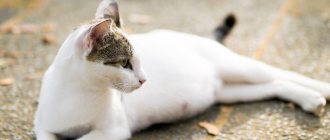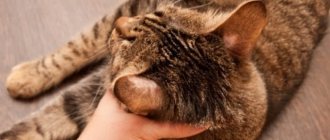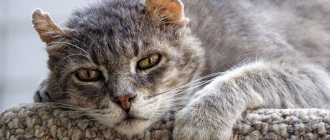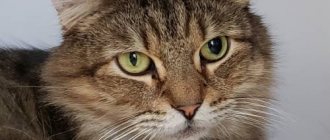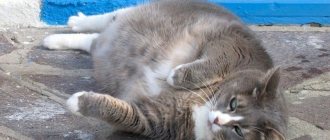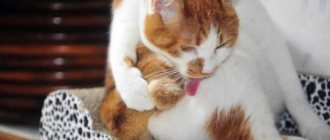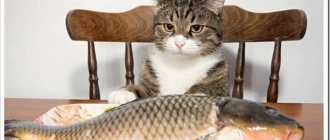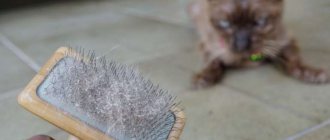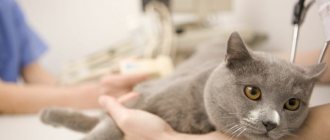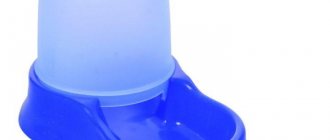6814Administration
Everyone knows that a cat's tail is a kind of indicator of the mood of a four-legged pet. A dissatisfied, excited or angry cat signals its feelings by twitching this part of its body. The tail is also necessary for coordinating cat movements. In some cases, you can observe a crooked tail in cats. This phenomenon is much more common in cats than in dogs. What does this feature mean? What causes a crease to form and is it dangerous to the cat’s health?
Types of tail deformation
Tail deformation can be of several types; the most common are kinks, kinks and bends. When a bend occurs, the next vertebra of the tail rises above the previous one, resulting in the formation of a “step up the ladder.” Deformed vertebrae differ in size and have rounded edges.
The opposite defect is a fracture, in which the vertebrae are located “step down”.
The bend is clearly visible to the naked eye; it seems that several vertebrae have “jumped out” beyond the imaginary line that runs through the middle of the vertebrae from the base to the tip of the tail. The bodies of the protruding vertebrae often have a wedge-shaped shape.
Maine Coon: description of the breed
It is easy to distinguish a purebred animal - it is distinguished by its large build, massive head, powerful chest, elongated and long body, strong and muscular.
The head is massive, large, sharply defined. Should not be round.
The ears are wide, pubescent, crowned with tassels at the tips.
Eyes – slightly slanted, large, expressive, different shades are possible, clean ones are desirable. There is no correlation between eye color and coat color.
The nose is of medium length, without a hump. The presence of a stop (pronounced depression, like the Persians) is unacceptable.
The coat is short on the shoulders, paws, head, longer on the back and sides. The texture is pleasant to the touch, silky.
Color - Maine Coons (as can be seen in the photo for the article), all options are acceptable - from chocolate and red to color variations with white.
The body is elongated and developed. Addition is proportional.
The paws are large, with fur growing between the toes.
The tail is long, fluffy, wider at the base, tapering towards the end.
Flaws:
- Size mismatch.
- Sharp muzzle.
- Eyes of irregular shape.
- Slim body with light bones.
- Short hair.
- Thin long paws.
A description of the Maine Coon cat breed would be incomplete without indicating the weight and information about what sizes these animals reach. It appears to be a very plump animal. This misconception is associated with the appearance of a big guy with lynx ears. But the impression made is deceiving. It is formed due to the physique features of the pets of this breed - a massive neck, strong bones, and a long body. That is why many imagine that this domesticated inhabitant of the North American expanses can weigh up to 15 kg or more.
So how much does a Maine Coon really weigh? Females - from 4 to 7 kg, females - from 8 to 10. Moreover, the figure changes as the animal grows older. Babies are born larger than representatives of other breeds (approximately 120-170 g). For comparison: for Persians it is 80-120 g. The rate of weight gain and body weight gain also depend on the gender of the pet - females are lighter, and males are heavy. By the age of three, your affectionate and gentle animal can gain up to 7.5 - 12 kg. And this is the norm. It is only unacceptable to exceed the 10 kg mark at an early age (1-2 years). This indicates health problems that cause obesity.
But we have not listed all the characteristics - the growth of Maine Coon cats is measured in length. It can reach one meter.
For some, such a great friend is just a dream. However, the dimensions of this native are not a hindrance for the other residents of the city apartment. The main thing is to provide a place for the new family member to play, because without activity the good-natured giants will wither away.
Why is the tail “broken”
Kittens with tail deformities can appear in litters of both outbred and purebred cats. Instead of a straight tail, the owners see tails bent to the side, broken in several places, or hooked. Regardless of the type of deformity, such a deviation permanently prohibits access to breeding and exhibitions. A fluffy kitten can become an excellent pet that retains all the characteristics of the breed, but the animal forever falls into the “home only” category.
Slight miscorrection of the tail, which is expressed in the last and penultimate vertebrae, is acceptable in some breeds, but breeding animals in such a situation is not recommended.
Veterinarians and breeders say that “unique” tails indicate the degeneration of the breed and are a serious genetic defect. When breeding such animals, you put all the offspring at risk, since the next generations may have not only a crooked tail, but also serious spinal disorders. Curvature of the spine is a direct path to congenital pathologies of internal organs, as a result of which the offspring will be non-viable.
The exact nature of such genetic abnormalities has not been established, but assumptions agree that closely related relationships are to blame.
Comments
Of course, it can be straightened - if the last and penultimate vertebrae (not higher) are broken, they can be quickly removed, and if the judges don’t take an x-ray, they won’t guess (with good plastic surgery of the tip) that there’s something wrong with the tail. Another question is ethical. Even two.
1. Is it worth torturing a kitten with surgery under general anesthesia for the sake of “beauty”? The gym does not interfere with his life at all. 2. Is it worth breeding an animal that has a gall, because it is inherited.
If I got such a kitten, I would probably talk to his breeders and ask for part of the money back - the difference between a show class and just a favorite. I would present an x-ray as a document explaining the reasons.
Thank you, part of the question is whether tail straightening surgery will be painful or difficult during and after, and whether it can affect the kitten’s psyche. It is the very last or penultimate vertebra that is broken. In fact, now, while the kitten's tail is not yet pubescent, this can be seen quite clearly. But maybe over time the tail will become pubescent, as is typical for the tails of Maine Coons - at the end there will be a bunch of these long flying strands of feathers, then perhaps the flaw will be less noticeable.
The kitten was not sold for breeding. There are now only three coon nurseries in Israel and all hold breeding licenses - and only sell castrated kittens - for exhibitions and as pets.
We took a cat from a litter in which three kittens were born with short, half-length tails. Ours and the other one came out normal - so it seemed to us. Now it’s clear why the owners of the nursery said that they wanted to close the case - their pair of sires had a useless genetic line. When we agreed on the purchase, we were not yet sure that we would want to participate in exhibitions, so this point was not particularly discussed. In a month of waiting until the cat reaches 3 months of age, he will be castrated and given to us - they matured, got tired of waiting, rushed over and took the cat almost without hesitation.
